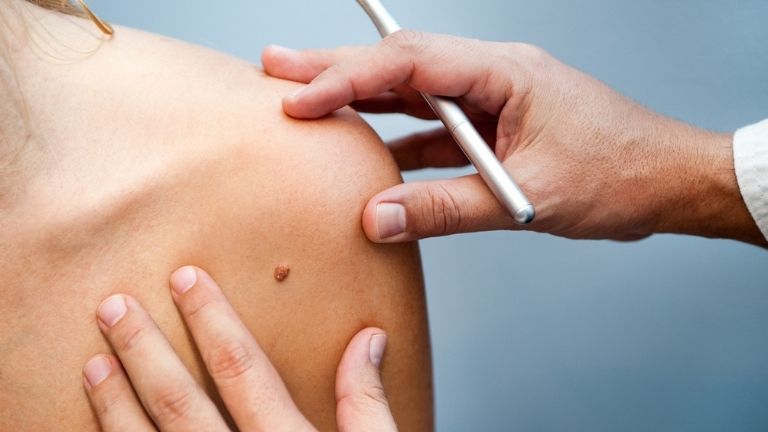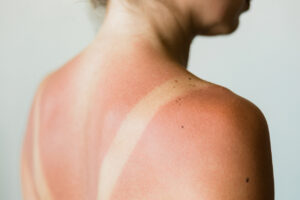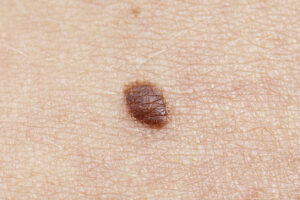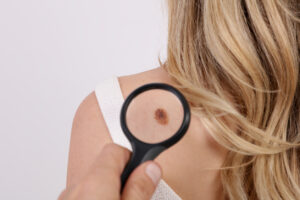What are the warning signs of cancerous moles? Healthista spoke to Lead Screening Nurse at The MOLE Clinic, Laura Harker who reveals the common signs and what to do about them
Melanoma skin cancer is the fifth most common cancer in the UK.
In fact, incidence rates for melanoma skin cancer are projected to rise by 7 per cent in the UK between 2014 and 2035, to 32 cases per 100,000 people by 2035.
With rates rising, it’s more important than ever that we give ourselves the best possible chance at beating skin cancer, and this can be done with early diagnosis.
there are around 16,200 new melanoma cases in the UK every year
This is why it is paramount we check ourselves as often as we can to monitor for any changes on our skin – especially as there are around 16,200 new melanoma cases in the UK every year.
Currently more than 5 million people are on waiting lists for NHS hospital treatments and 44 new melanoma skin cancer cases are confirmed in the UK every day.
Despite being more common with increasing age, melanoma is actually disproportionately high in younger people.
What causes skin cancer?
Melanoma skin cancer – the most serious form of skin cancer – is caused by sunburn (although not exclusively).
According to Cancer Research UK, in the UK, around 85 out of 100 melanomas (around 85 per cent) are caused by too much ultraviolet radiation.
When it comes to developing skin cancer, there are some people who are at higher risk, such as those with skin type 1 – individuals who always burn and never tan and often have red hair and freckles.
Also those with skin type 2 – individuals who usually burn and tan minimally, they have fair skin and hair. Those with a history of sunbeds and / or sunburn are also at a higher risk.
around 85 out of 100 melanomas (around 85 per cent) are caused by too much ultraviolet radiation
Plus, you may also be at risk if you have 100+ moles, a personal history or family history of melanoma or with many atypical moles, and patients who are immunosuppressed.
However, that’s not to say that if you don’t identify with any of these categories that you don’t need to be vigilant when out in the sun.
Whenever our skin changes colour, this is due to the cells in our body changing to try and protect us from harmful UV rays from the sun.
So even if you’re not suffering from sun burn, your skin is still showing signs of damage. Even if you have darker skin, you should also be aware though your skin might not look affected, damage can still be taking place.
What are the signs of skin cancer?
A key warning sign that a mole (or other skin lesion) might be skin cancer is when a mole is noticeably new or changing.
Another warning sign is when a mole stands out and looks different to other moles; this is called the ‘ugly duckling.’
A normal mole changes so slowly that change should not be very noticeable, and a normal mole usually looks like those around it.
Everyone should be aware of the ABCDE test for moles as it is simple to use.
The warning signs are:
A for Asymmetry – Look for moles that are asymmetrical in shape, where one half of the mole is unlike the other.
B for Border irregularity – Does the mole have an irregular border? Is it scalloped, jagged or poorly defined?
C for Colour differences and comparison – Does the mole have two or more different colours and does it look different to your other moles?
D for Diameter changing – Check the diameter of the mole to see if it is bigger than 7mm (about the size of the end of a pencil). However, most skin cancers start off smaller than this and it is important to check for any lesion that is new, changing or unusual regardless of size.
EFG – all of Elevated, Firm and Growing (sustained growth) – Is the mole evolving or changing size shape or colour? Is the mole or skin lesion elevated, firm to touch and growing in a sustained manner?
If you are able to answer ‘yes’ to any of the above questions, it would be sensible and advised to have the mole checked by your GP or by a skin specialist such as The MOLE Clinic.
Different types of moles:
Melanocytic naevi are pigmented moles. The word ‘melanocytic’ means that they are made up of the cells (melanocytes) which produce the dark pigment (melanin) that gives the skin its colour.
There are three main types of acquired melanocytic naevi:
- Junctional melanocytic naevi are flat, and usually circular. Their colour is usually even, and ranges from mid to dark brown.
- Compound melanocytic naevi are raised brown bumps, most of which are hairy. Some have a slightly warty surface.
- Intradermal melanocytic naevi are raised, often hairy, bumps, similar to compound naevi, but more pale coloured (often skin-coloured).
In childhood, most moles are of the junctional type (flat and usually circular). Later in life some become raised and more hairy, and moles on the face often become pale over time.
There are several other, less common, types of mole. These include:
- Blue naevus – a harmless mole with a dark blue colour.
- Halo naevus – a mole surrounded by a pale ring (compared to the skin) which may gradually go away by itself.
- Dysplastic or atypical naevi – these are usually multiple, with irregular pigmentation and shape, and run in some families. They have a greater tendency than most moles to change into a melanoma, which is a skin cancer.
How often should we check our moles?
A tendency to have multiple moles runs in some families. Sunburn or excessive sun exposure contribute to new moles formation and people with fair skin are more at risk.
Any new moles appearing in adulthood need to be monitored and checked if growing or changing. The ABCDE test is the best way to monitor moles and make a judgement on if you need to seek advice from your GP.
skin should be examined regularly for moles that are growing
If you have a large number of moles, skin should be examined regularly for moles that are growing, or changing.
Are moles getting bigger, is the shape (becoming asymmetrical with an irregular ragged edge) or the colour is it uneven with different shades of black, brown or pink.
Also, if it has a tendency to bleed, ooze or scab or if a mole is very different from the other moles on the skin.
How can we prevent moles and skin cancer?
Protect your skin with adequate clothing, wear a hat that protects your face, neck and ears and a pair of UV protective sunglasses. Choose sun protective clothing (with permanently sun-protective fabric, widely available for adults and children) if you have fair skin or many moles.
Spend time in the shade between 11am and 3pm when it’s sunny. Step out of the sun before your skin has a chance to redden or burn.
When choosing a sunscreen look for a broad spectrum, high protection SPF which will protect against UVB and UVA.
Apply plenty of sunscreen 15 to 30 minutes before going out in the sun
The sun protection factor (SPF) protects against UVB which is responsible for the immediate sun damage; sunburn. UVA is responsible for the long term sun damage and premature aging. 4-5 star UVA protection is recommended.
Apply plenty of sunscreen 15 to 30 minutes before going out in the sun, and reapply every two hours and straight after swimming, towel-drying or sweating.
Sunscreens are not an alternative to clothing and shade, rather they offer additional protection. No sunscreen will provide 100% protection. Keep babies and young children out of direct sunlight.
What do we do if we see a mole that doesn’t look right?
If you have a concern about a mole or moles you should see your GP as soon as possible.
Ask a family member or a friend to examine your back and taking a photograph is helpful to monitor anything new or changing.
What are the next steps after telling your GP about your mole?
The British Association of Dermatologists recommends that you tell your doctor about any changes to a mole or patch of skin.
If your GP is concerned about your skin you are advised to see a Consultant Dermatologist – an expert in diagnosing skin cancer. Your doctor can refer you for free through the NHS.
More Healthista Content:
How to protect yourself from coronavirus now that things are back to normal – an expert guide
7 types of skin moles and exactly what to do about them
‘The skincare clinic that helped clear my cystic acne’
Pelvic Floor FAQ’s – here’s what you need to know
5 reasons you’re not seeing results from your workout routine
Like this article? Sign up to our newsletter to get more articles like this delivered straight to your inbox.


























































